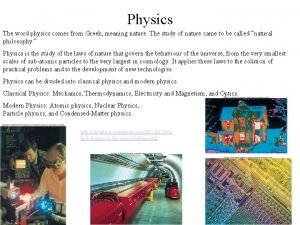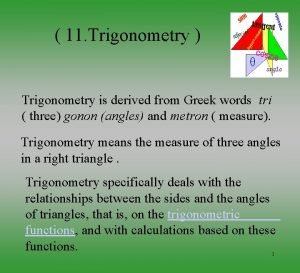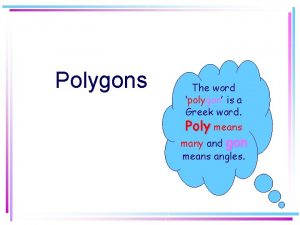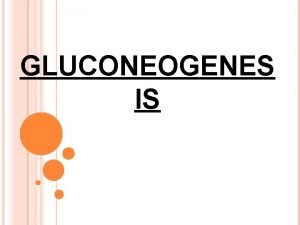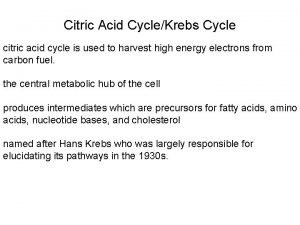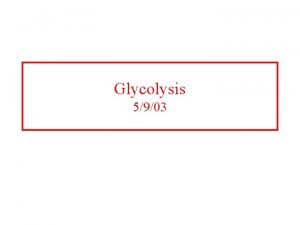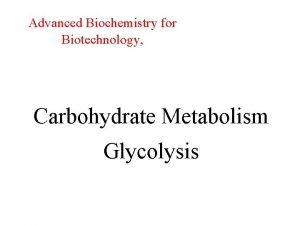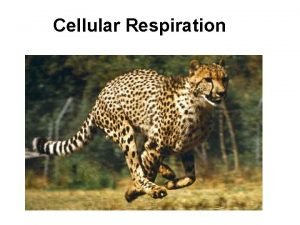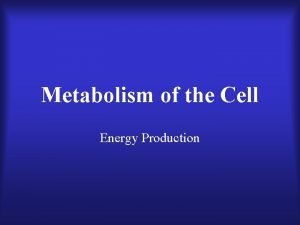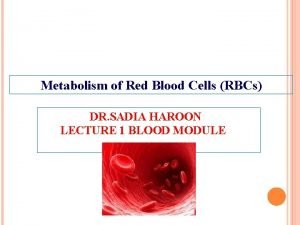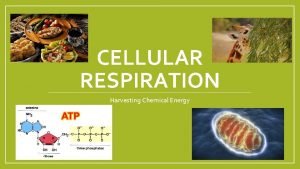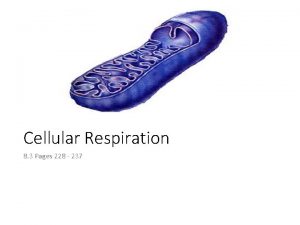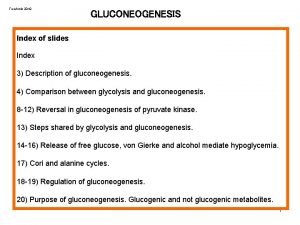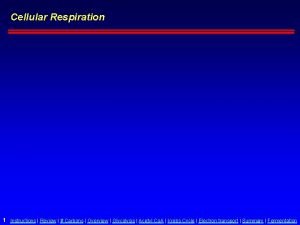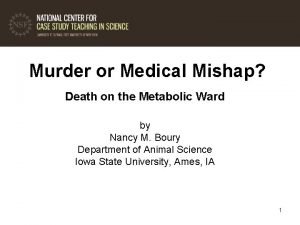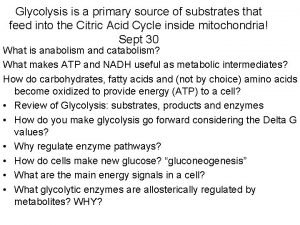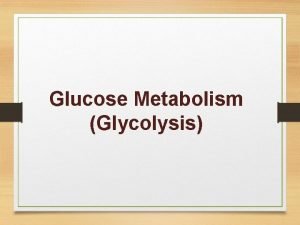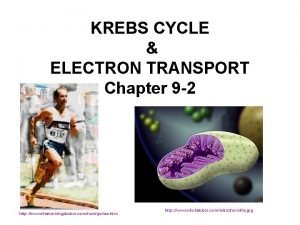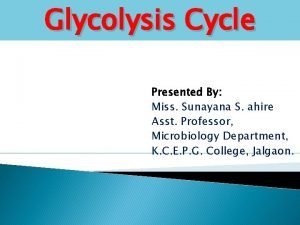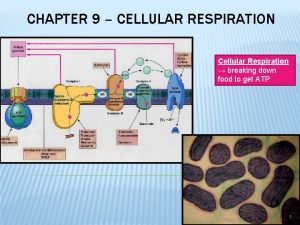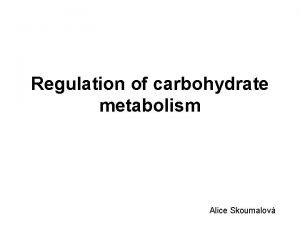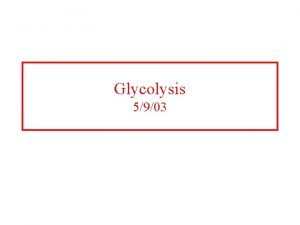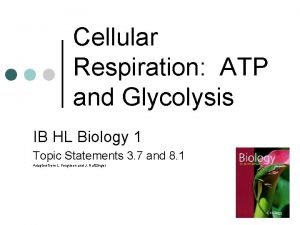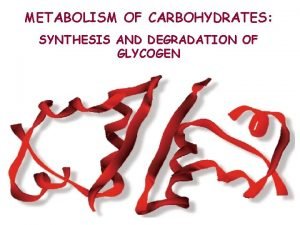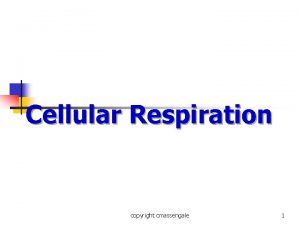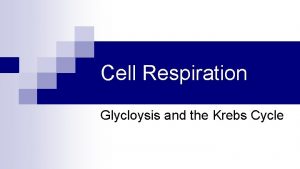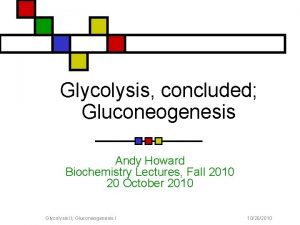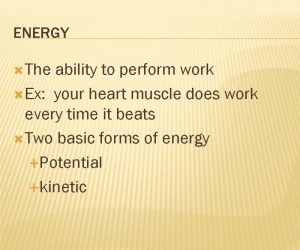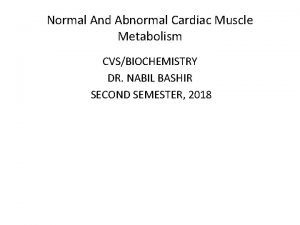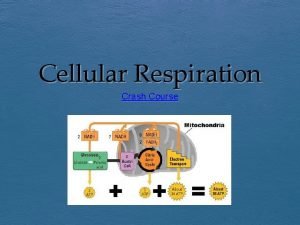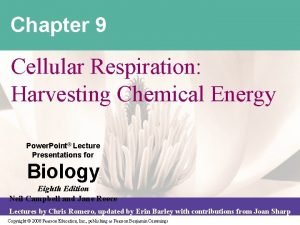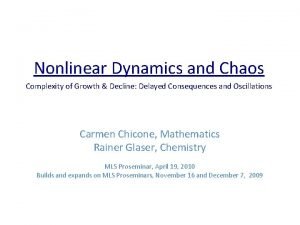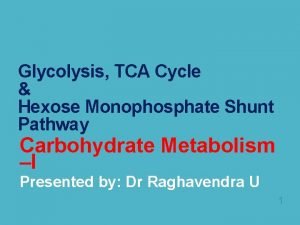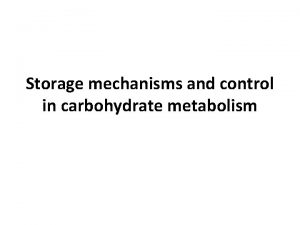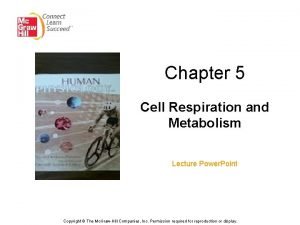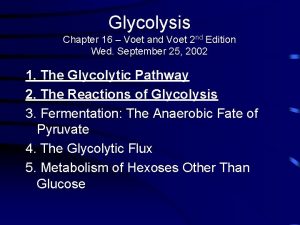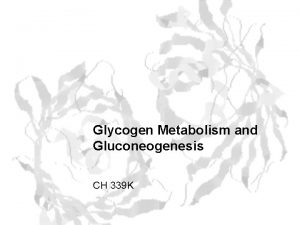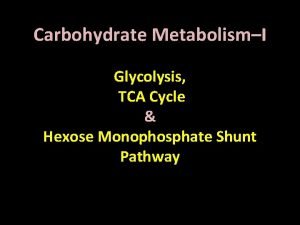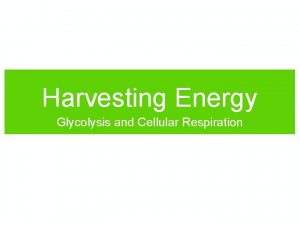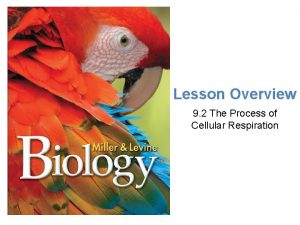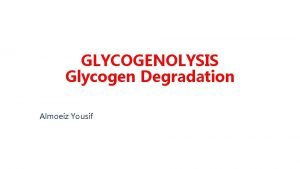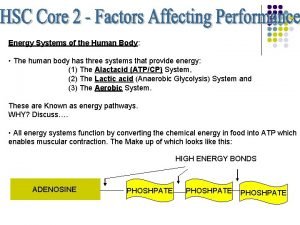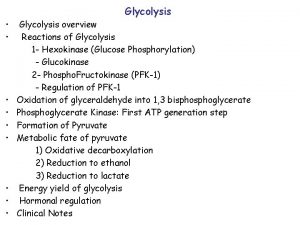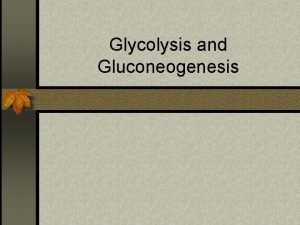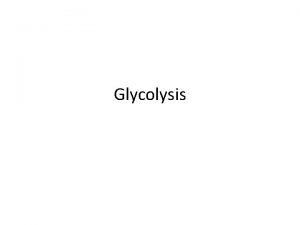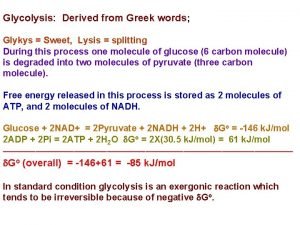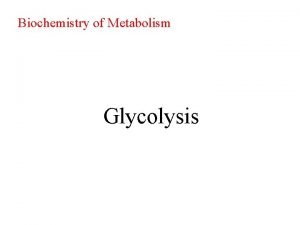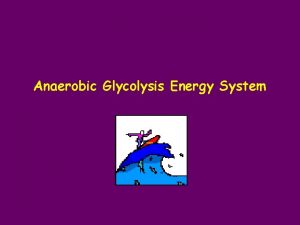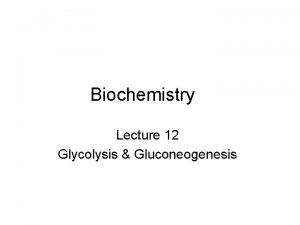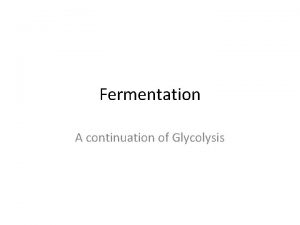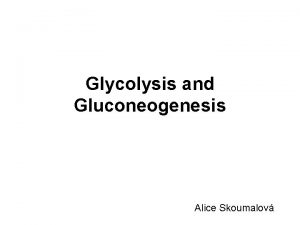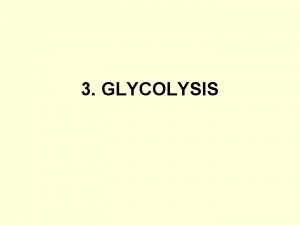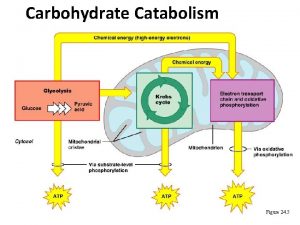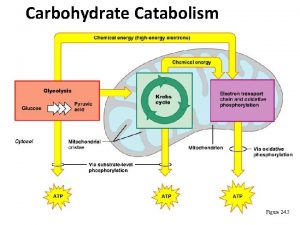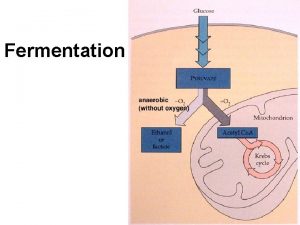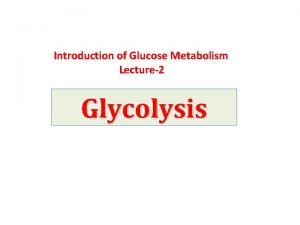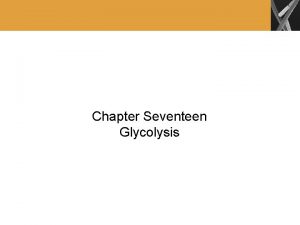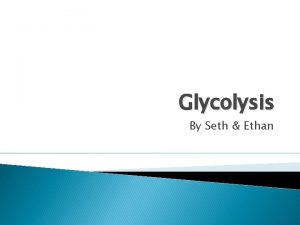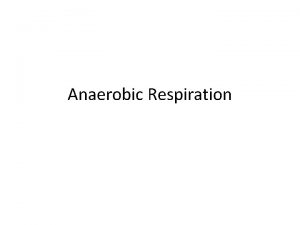17 Glycolysis Derived from the Greek stem glyk


















































- Slides: 50

17 Glycolysis Derived from the Greek stem glyk-, "sweet, " and the word lysis, "dissolution. " 17 -1

17 Learning Objectives 1. What Is the Overall Pathway in Glycolysis? 2. How Is the 6 -Carbon Glucose Converted to the 3 -Carbon Glyceraldehyde-3 Phosphate? 3. How Is Glyceraldehyde-3 -Phosphate Converted to Pyruvate? 4. How Is Pyruvate Metabolized Anaerobically? 5. How Much Energy Can Be Produced by Glycolysis? 17 -2

17 The Glycolytic Pathway Glucose is converted to two pyruvate 17 -3

17 Questions • Site of glycolysis ? • Why it is important ? • Which organs rely on glycolysis ? 17 -4

17 17 -5

17 17 -6

17 17 -7

17 Glycolysis • Glycolysis: a series of 10 enzyme-catalyzed reactions by which glucose is oxidized to two molecules of pyruvate • there is net conversion of 2 ADP to 2 ATP 17 -8

17 Fates of Pyruvate • Pyruvate is most commonly metabolized in one of three ways, depending on the type of organism and the presence or absence of O 2 aerobic conditions plants and animals O CH 3 CCOO Pyruvate anaerobic conditions contracting muscle 2 CO 2 + 2 H 2 O OH CH 3 CHCOOLactate anaerobic conditions CH 3 CH 2 OH + CO 2 fermentation in yeast Ethanol 17 -9

17 The Reactions of Glycolysis 1. Phosphorylation of glucose to give glucose-62. 3. 4. 5. phosphate Isomerization of glucose-6 -phosphate to give fructose-6 -phosphate Phosphorylation of fructose-6 -phosphate to yield fructose-1, 6 -bisphosphate Cleavage of fructose-1, 6, -bisphosphate to give glyceraldehyde-3 -phosphate and dihyroxyacetone phosphate Isomerization of dihyroxyacetone phosphate to give glyceraldehyde-3 -phosphate 17 -10

17 The Reactions of Glycolysis (Cont’d) 6. Oxidation of glyceraldehyde-3 -phosphate to give 1, 3 -bisphoglycerate 7. Transfer of a phosphate group from 1, 3 bisphoglycerate to ADP to give 3 phosphoglycerate 8. Isomerization of 3 -phosphoglycerate to give 2 phosphoglycerate 9. Dehydration of 2 -phosphoglycerate to give phosphoenolpyruvate 10. Transfer of a phosphate group from phosphoenolpyruvate to ADP to give pyruvate 17 -11

17 Glycolysis - Reaction 1 • Reaction 1: phosphorylation of -D-glucose 17 -12

17 Glycolysis - Reaction 1 • Phosphorylation of glucose • this reaction is endergonic and driven by the free energy of hydrolysis of ATP 17 -13

17 Glycolysis - Reaction 1 • catalyzed by hexokinase (in non-hepatic cells) • a large conformational change takes place when substrate is bound to the enzyme Hexokinase and hexokinase-glucose complex 17 -14

17 Glycolysis - Reaction 1 • The ATP-dependent phosphorylation of glucose to form glucose 6 -phosphate is catalyzed by hexokinase. • The phosphorylation has two goals: First, the hexokinase reaction converts nonionic glucose into an anion that is trapped in the cell, since cells lack transport systems for phosphorylated sugars. Second, the biologically inert glucose becomes activated into a form capable of being further metabolized. 17 -15

17 • Four mammalian isozymes of hexokinase are known (Types I - IV), with the Type IV isozyme often referred to as glucokinase. Glucokinase is found in liver cells. The high Km of glucokinase for glucose means that this enzyme is saturated only at very high concentrations of substrate (glucokinase has lower affinity to glucose than hexokinase). 17 -16

17 Glycolysis - Reaction 2 • Reaction 2: isomerization of glucose-6 -phosphate to fructose-6 -phosphate 17 -17

17 Glycolysis - Reaction 2 • this isomerization is most easily seen by considering the open-chain forms of each monosaccharide; it is one keto-enol tautomerism followed by another 17 -18

17 Glycolysis - Reaction 3 • Reaction 3: phosphorylation of fructose-6 - phosphate 17 -19

17 Glycolysis - Reaction 3 • Phosphofructokinase: a key regulatory enzyme in the metabolism of glucose • • • a tetramer and subject to allosteric feedback the tetramer is composed of L and M subunits M 4, M 3 L, M 2 L 2, ML 3, and L 4 are exist muscles are rich in M 4; the liver is rich in L 4 ATP is an allosteric effector; high levels inhibit the enzyme, low levels activate it • fructose-2, 6 -bisphosphate is also an allosteric effector 17 -20

17 Glycolysis - Reaction 3 Phosphofructokinase is an allosteric enzyme 17 -21

17 Glycolysis - Reaction 4 • Reaction 4: cleavage of fructose-1, 6 -bisphosphate to two triose phosphates 17 -22

17 Glycolysis - Reaction 5 • Reaction 5: isomerization of triose phosphates • catalyzed by triosephosphate isomerase • reaction involves two successive keto-enol tautomerizations • only the D enantiomer of glyceraldehyde 3 -phosphate is formed 17 -23

17 Glycolysis - Reaction 6 • Reaction 6: oxidation of the D-glyceraldehyde-3 - phosphate to 1, 3 bisphoglycerate by glyceraldehyde-3 -phosphate dehydrogenase • the -CHO group is oxidized to a carboxyl group • the oxidizing agent, NAD+, is reduced to NADH 17 -24

17 Glycolysis - Reaction 6 • the overall reaction involves an exergonic oxidation and an endergonic phosphorylation • the overall reaction is slightly endergonic 17 -25

17 Glycolysis - Reaction 7 • Reaction 7: transfer of a phosphate group from 1, 3 -bisphoglycerate to ADP • this reaction is called substrate-level phosphorylation 17 -26

17 Glycolysis - Reaction 7 • This reaction is the sum of the endergonic phosphorylation of ADP and the exergonic hydrolysis of the mixed phosphate anhydride phosphorylation: AD P + Pi o' -1 G = +30. 5 k. J • mol ATP + H 2 O hydrolysis: O O C-O- P-O - + H 2 O OO O C-O- P-O - + AD P + Pi O- O C-O - + Pi G = -49. 3 k. J • mol O o' -1 C-O - + ATP G = -18. 8 k. J • mol 17 -27

17 Glycolysis - Reaction 8 • Reaction 8: isomerization of 3 -phosphoglycerate to 2 -phosphoglycerate COOH C OH phosphoglyceromutase CH 2 OPO 3 2 3 -Phosphoglycerate COOH C OPO 3 2 CH 2 OH 2 -Phosphoglycerate 17 -28

17 Glycolysis - Reaction 9 • Reaction 9: dehydration of 2 -phosphoglycerate 17 -29

17 Glycolysis - Reaction 10 • Reaction 10: 10 phosphate transfer to ADP • stage 1: transfer of the phosphate group 17 -30

17 Glycolysis - Reaction 10 • stage 2: enolization to pyruvate • reaction 10 is the sum of an exergonic hydrolysis and an endergonic phosphorylation of ATP 17 -31

17 Glycolysis • Summing these 10 reactions gives the net equation for glycolysis 17 -32

17 Energetics of Glycolysis • The free energy change, G°′, for the 10 reactions of glycolysis are variously negative and positive but, taken together, occur with a large decrease in free energy • Three reactions exhibit particularly large decreases in free energy; the enzymes that catalyze these reactions are sites of allosteric control • hexokinase • phosphofructokinase • pyruvate kinase 17 -33

17 Control Points in Glycolysis §Step 1: Hexokinase is inhibited by glucose-6 -p §Step 3: phosphofructokinase is inhibited by ATP §Step 10: pyruvate kinase is inhibited by ATP 17 -34

17 17 -35

17 Summary • In the final stages of glycolysis, two molecules of pyruvate are produced for each molecule of glucose that entered the pathway • These reactions involve electron transfer, and the net production of two ATP for each glucose • There are three control points in the glycolytic pathway 17 -36

17 Anaerobic Metabolism of Pyruvate • Pyruvate does not accumulate in cells, but rather undergoes one of three enzymecatalyzed reactions, depending of the type of cell and its state of oxygenation Øreduction to lactate (lactate fermentation) Øreduction to ethanol (ethanol fermentation) Øoxidative decarboxylation to acetyl-Co. A 17 -37

17 • A key to understanding the biochemical logic behind two of these fates is to recognize that glycolysis needs a continuing supply of NAD+ Øif no oxygen is present to reoxidize NADH to NAD+, then another way must be found to reoxidize it 17 -38

17 Lactate Fermentation • In vertebrate muscle under anaerobic conditions, the most important pathway for the regeneration of NAD+ is reduction of pyruvate to lactate • lactate dehydrogenase (LDH) is a tetrameric isoenzyme consisting of H and M subunits; H 4 predominates in heart muscle, and M 4 in skeletal muscle 17 -39

17 Pyruvate to Lactate • while lactate fermentation allows glycolysis to continue, it increases the concentration of lactate and also of H+ in muscle tissue • when blood lactate reaches about 0. 4 mg/100 m. L, muscle tissue becomes almost completely exhausted 17 -40

17 Glucose to Lactate • Lactate fermentation occurs with a significant decrease in free energy 17 -41

17 Glucose to Lactate 17 -42

17 Pyruvate to Ethanol • Yeasts and several other organisms regenerate NAD+ by this two-step pathway • decarboxylation of pyruvate to acetaldehyde Mg 2+, TPP • reduction of acetaldehyde to ethanol 17 -43

17 Structures of Thiamine and TPP 17 -44

17 Pyruvate to Ethanol 17 -45

An ethanol fuel plant in West 17 Burlington, Iowa 17 -46

FETAL ALCOHOL SYNDROME 17 can be detected by measuring the level of acetaldehyde in the blood stream of a pregnant woman 17 -47

17 DENTAL CARIES 17 -48

17 Summary • Pyruvate is converted to lactate in anaerobic tissues, such as actively metabolizing muscle. NAD+ is recycled in the process • In some organisms, pyruvate is converted to ethanol in a process requiring thiamine pyrophosphate as a coenzyme 17 -49

17 End Chapter 17 17 -50
 Greek word of physics
Greek word of physics The word photography comes from the greek words
The word photography comes from the greek words Educational technology is derived from a greek word
Educational technology is derived from a greek word The value of cos600 cos300 - sin600 sin300 equals
The value of cos600 cos300 - sin600 sin300 equals The word geometry is derived from
The word geometry is derived from What is the meaning of the greek word poly and gon
What is the meaning of the greek word poly and gon What are the substrates for gluconeogenesis
What are the substrates for gluconeogenesis Glycolysis inputs and outputs
Glycolysis inputs and outputs +atp
+atp Pyruvate kinase
Pyruvate kinase Glycolysis
Glycolysis Atp glycolysis
Atp glycolysis Glycolysis phases
Glycolysis phases Glutathione structure and function
Glutathione structure and function End result of glycolysis
End result of glycolysis Where does glycolysis take place
Where does glycolysis take place Pyruvate carboxylase
Pyruvate carboxylase Glycolysis
Glycolysis Fructose 1 phosphate glycolysis
Fructose 1 phosphate glycolysis Glycolysis in muscle cells
Glycolysis in muscle cells Glycolysis atp yield
Glycolysis atp yield Citric acid cycle overall reaction
Citric acid cycle overall reaction Krebs cycle and electron transport chain
Krebs cycle and electron transport chain Defination of atp
Defination of atp Investment phase of glycolysis
Investment phase of glycolysis Glycolysis
Glycolysis Glucose + atp
Glucose + atp Atp biology
Atp biology Hcoh
Hcoh Glycogen cycle
Glycogen cycle Substrate of cellular respiration
Substrate of cellular respiration Energy investment phase of glycolysis
Energy investment phase of glycolysis Pasteur effect
Pasteur effect Glycolysis reactants
Glycolysis reactants Glycolysis in cardiac muscle
Glycolysis in cardiac muscle Crash course electron transport chain
Crash course electron transport chain Energy investment phase of glycolysis
Energy investment phase of glycolysis Energy flow in cellular respiration
Energy flow in cellular respiration Glycolysis
Glycolysis Significance of hmp shunt in biochemistry
Significance of hmp shunt in biochemistry Gluconeogenesis meaning
Gluconeogenesis meaning Glycolysis reactants
Glycolysis reactants Glycolysis
Glycolysis Glycogen in glycolysis
Glycogen in glycolysis Clinical significance of glycolysis
Clinical significance of glycolysis Atp glycolysis
Atp glycolysis Electron carriers in cellular respiration
Electron carriers in cellular respiration Glycolysis occurs in the
Glycolysis occurs in the The final product of glycolysis is
The final product of glycolysis is Significance of glycogenolysis
Significance of glycogenolysis The body's three energy systems
The body's three energy systems
